Executive Summary: Strategy Analysis of Infosys Technologies
VerifiedAdded on 2021/05/31
|12
|2220
|259
Report
AI Summary
This report presents a comprehensive strategic analysis of Infosys Technologies, a prominent IT service company. It begins with an executive summary, followed by an in-depth examination of Infosys's current strategic situation, including its company strategy, the PSPD Model, and globalization strategy. The report evaluates the effectiveness of these strategies and identifies key challenges faced by the company. The analysis further explores Infosys's responsiveness to different national markets and the reasons behind its presence in specific regions. The core of the report proposes an alternative strategy for Infosys, aligning with current market developments. This strategy includes agile digital practices, employee skills development, leveraging core competencies, and a focus on localization. The report concludes by emphasizing the importance of a competency-based strategy to support Infosys's future endeavors. The report also references the company's reliance on its Aikido service and its three pillars of mindful automation, innovation, and education.
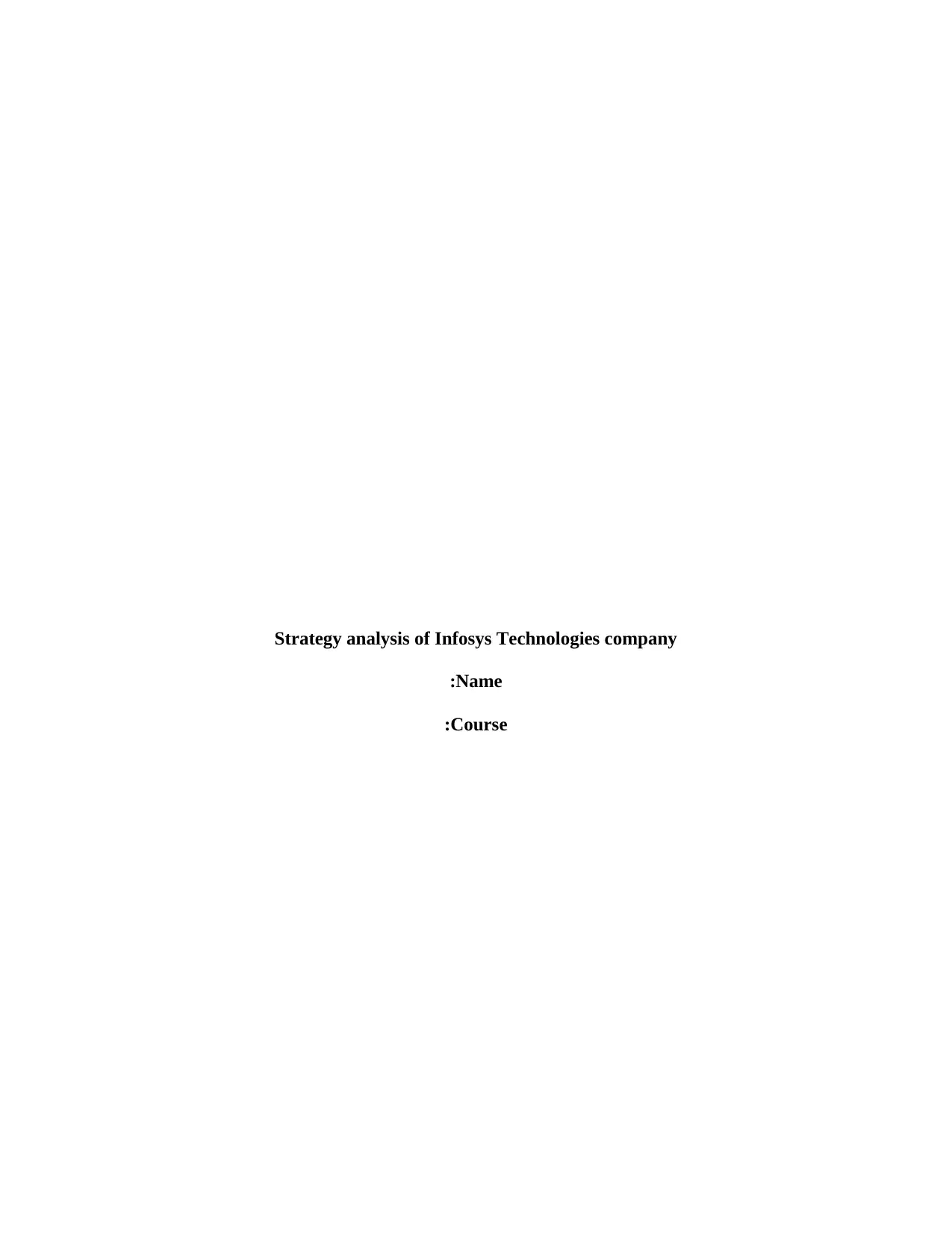
Strategy analysis of Infosys Technologies company
Name:
Course:
Name:
Course:
Paraphrase This Document
Need a fresh take? Get an instant paraphrase of this document with our AI Paraphraser
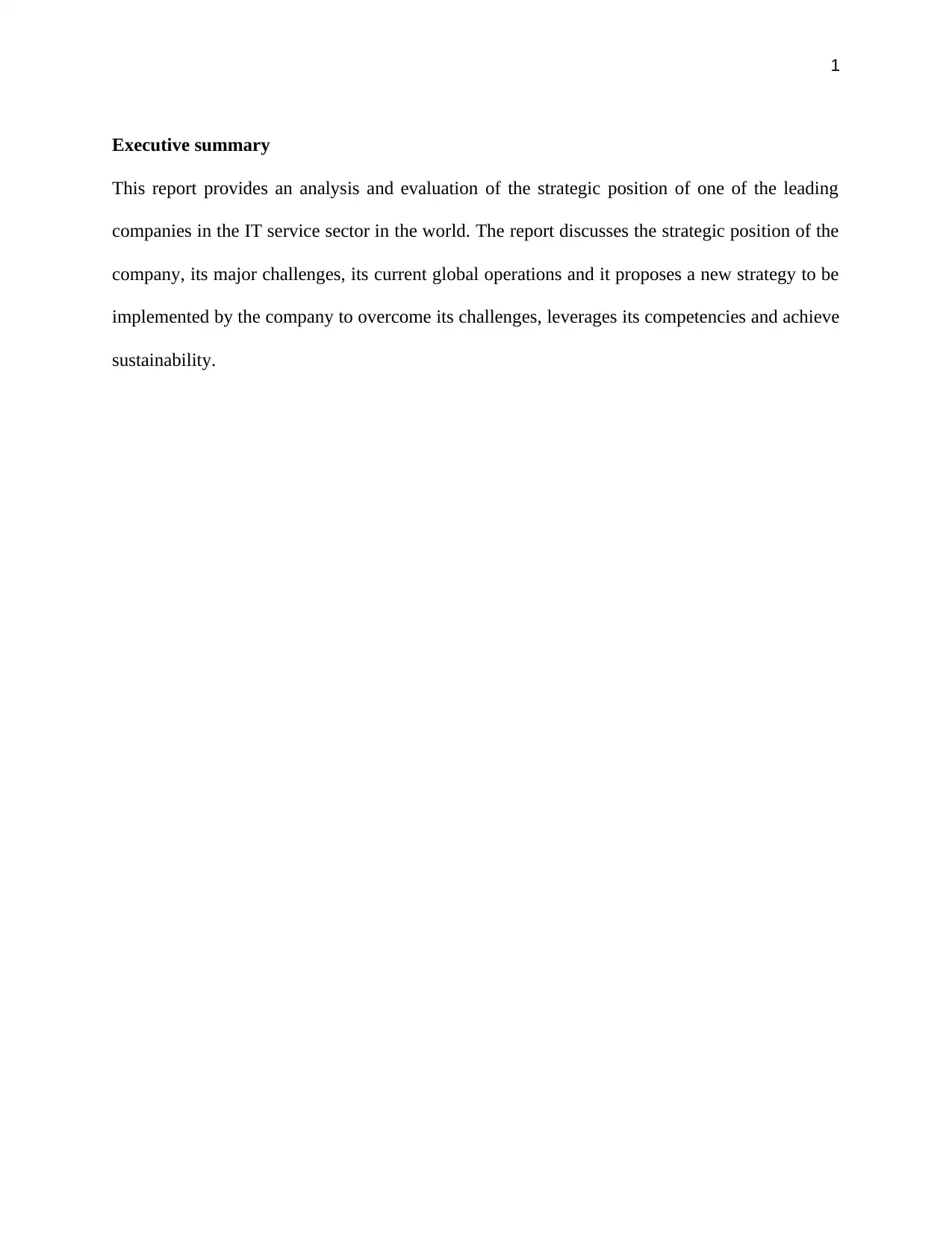
1
Executive summary
This report provides an analysis and evaluation of the strategic position of one of the leading
companies in the IT service sector in the world. The report discusses the strategic position of the
company, its major challenges, its current global operations and it proposes a new strategy to be
implemented by the company to overcome its challenges, leverages its competencies and achieve
sustainability.
Executive summary
This report provides an analysis and evaluation of the strategic position of one of the leading
companies in the IT service sector in the world. The report discusses the strategic position of the
company, its major challenges, its current global operations and it proposes a new strategy to be
implemented by the company to overcome its challenges, leverages its competencies and achieve
sustainability.
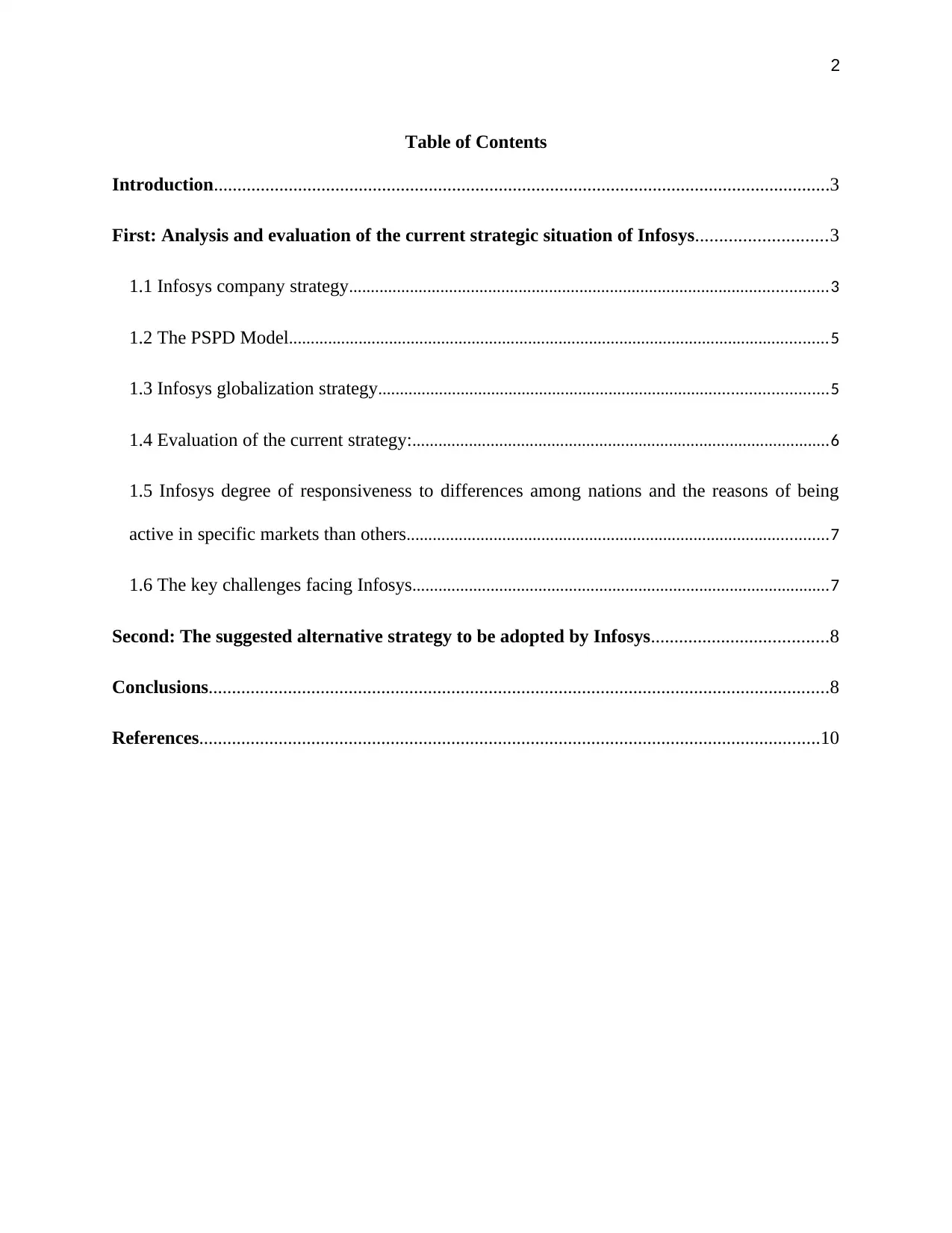
2
Table of Contents
Introduction....................................................................................................................................3
First: Analysis and evaluation of the current strategic situation of Infosys............................3
1.1 Infosys company strategy..............................................................................................................3
1.2 The PSPD Model............................................................................................................................5
1.3 Infosys globalization strategy.......................................................................................................5
1.4 Evaluation of the current strategy:................................................................................................6
1.5 Infosys degree of responsiveness to differences among nations and the reasons of being
active in specific markets than others.................................................................................................7
1.6 The key challenges facing Infosys................................................................................................7
Second: The suggested alternative strategy to be adopted by Infosys......................................8
Conclusions.....................................................................................................................................8
References.....................................................................................................................................10
Table of Contents
Introduction....................................................................................................................................3
First: Analysis and evaluation of the current strategic situation of Infosys............................3
1.1 Infosys company strategy..............................................................................................................3
1.2 The PSPD Model............................................................................................................................5
1.3 Infosys globalization strategy.......................................................................................................5
1.4 Evaluation of the current strategy:................................................................................................6
1.5 Infosys degree of responsiveness to differences among nations and the reasons of being
active in specific markets than others.................................................................................................7
1.6 The key challenges facing Infosys................................................................................................7
Second: The suggested alternative strategy to be adopted by Infosys......................................8
Conclusions.....................................................................................................................................8
References.....................................................................................................................................10
⊘ This is a preview!⊘
Do you want full access?
Subscribe today to unlock all pages.

Trusted by 1+ million students worldwide
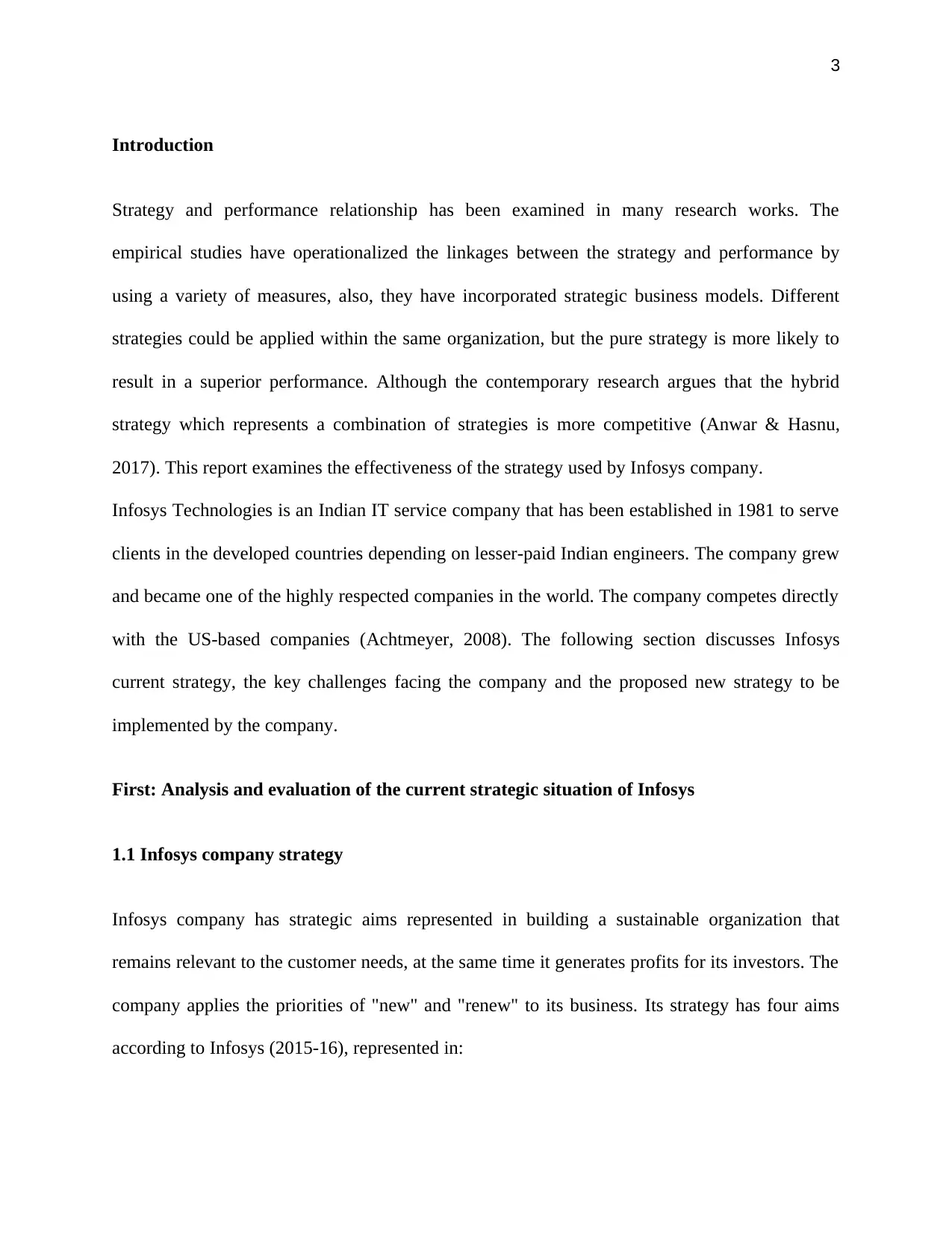
3
Introduction
Strategy and performance relationship has been examined in many research works. The
empirical studies have operationalized the linkages between the strategy and performance by
using a variety of measures, also, they have incorporated strategic business models. Different
strategies could be applied within the same organization, but the pure strategy is more likely to
result in a superior performance. Although the contemporary research argues that the hybrid
strategy which represents a combination of strategies is more competitive (Anwar & Hasnu,
2017). This report examines the effectiveness of the strategy used by Infosys company.
Infosys Technologies is an Indian IT service company that has been established in 1981 to serve
clients in the developed countries depending on lesser-paid Indian engineers. The company grew
and became one of the highly respected companies in the world. The company competes directly
with the US-based companies (Achtmeyer, 2008). The following section discusses Infosys
current strategy, the key challenges facing the company and the proposed new strategy to be
implemented by the company.
First: Analysis and evaluation of the current strategic situation of Infosys
1.1 Infosys company strategy
Infosys company has strategic aims represented in building a sustainable organization that
remains relevant to the customer needs, at the same time it generates profits for its investors. The
company applies the priorities of "new" and "renew" to its business. Its strategy has four aims
according to Infosys (2015-16), represented in:
Introduction
Strategy and performance relationship has been examined in many research works. The
empirical studies have operationalized the linkages between the strategy and performance by
using a variety of measures, also, they have incorporated strategic business models. Different
strategies could be applied within the same organization, but the pure strategy is more likely to
result in a superior performance. Although the contemporary research argues that the hybrid
strategy which represents a combination of strategies is more competitive (Anwar & Hasnu,
2017). This report examines the effectiveness of the strategy used by Infosys company.
Infosys Technologies is an Indian IT service company that has been established in 1981 to serve
clients in the developed countries depending on lesser-paid Indian engineers. The company grew
and became one of the highly respected companies in the world. The company competes directly
with the US-based companies (Achtmeyer, 2008). The following section discusses Infosys
current strategy, the key challenges facing the company and the proposed new strategy to be
implemented by the company.
First: Analysis and evaluation of the current strategic situation of Infosys
1.1 Infosys company strategy
Infosys company has strategic aims represented in building a sustainable organization that
remains relevant to the customer needs, at the same time it generates profits for its investors. The
company applies the priorities of "new" and "renew" to its business. Its strategy has four aims
according to Infosys (2015-16), represented in:
Paraphrase This Document
Need a fresh take? Get an instant paraphrase of this document with our AI Paraphraser
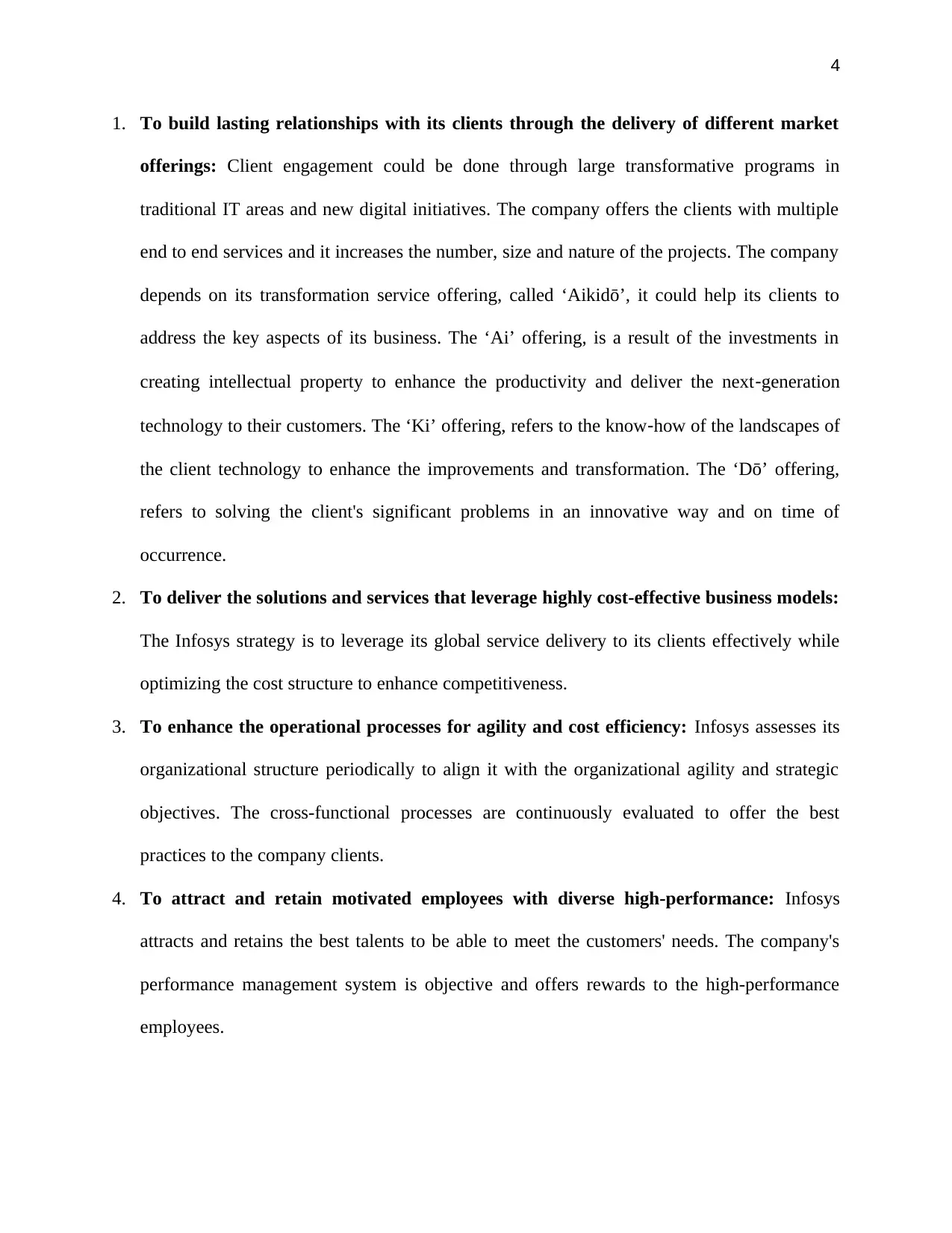
4
1. To build lasting relationships with its clients through the delivery of different market
offerings: Client engagement could be done through large transformative programs in
traditional IT areas and new digital initiatives. The company offers the clients with multiple
end to end services and it increases the number, size and nature of the projects. The company
depends on its transformation service offering, called ‘Aikidō’, it could help its clients to
address the key aspects of its business. The ‘Ai’ offering, is a result of the investments in
creating intellectual property to enhance the productivity and deliver the next-generation
technology to their customers. The ‘Ki’ offering, refers to the know-how of the landscapes of
the client technology to enhance the improvements and transformation. The ‘Dō’ offering,
refers to solving the client's significant problems in an innovative way and on time of
occurrence.
2. To deliver the solutions and services that leverage highly cost-effective business models:
The Infosys strategy is to leverage its global service delivery to its clients effectively while
optimizing the cost structure to enhance competitiveness.
3. To enhance the operational processes for agility and cost efficiency: Infosys assesses its
organizational structure periodically to align it with the organizational agility and strategic
objectives. The cross-functional processes are continuously evaluated to offer the best
practices to the company clients.
4. To attract and retain motivated employees with diverse high-performance: Infosys
attracts and retains the best talents to be able to meet the customers' needs. The company's
performance management system is objective and offers rewards to the high-performance
employees.
1. To build lasting relationships with its clients through the delivery of different market
offerings: Client engagement could be done through large transformative programs in
traditional IT areas and new digital initiatives. The company offers the clients with multiple
end to end services and it increases the number, size and nature of the projects. The company
depends on its transformation service offering, called ‘Aikidō’, it could help its clients to
address the key aspects of its business. The ‘Ai’ offering, is a result of the investments in
creating intellectual property to enhance the productivity and deliver the next-generation
technology to their customers. The ‘Ki’ offering, refers to the know-how of the landscapes of
the client technology to enhance the improvements and transformation. The ‘Dō’ offering,
refers to solving the client's significant problems in an innovative way and on time of
occurrence.
2. To deliver the solutions and services that leverage highly cost-effective business models:
The Infosys strategy is to leverage its global service delivery to its clients effectively while
optimizing the cost structure to enhance competitiveness.
3. To enhance the operational processes for agility and cost efficiency: Infosys assesses its
organizational structure periodically to align it with the organizational agility and strategic
objectives. The cross-functional processes are continuously evaluated to offer the best
practices to the company clients.
4. To attract and retain motivated employees with diverse high-performance: Infosys
attracts and retains the best talents to be able to meet the customers' needs. The company's
performance management system is objective and offers rewards to the high-performance
employees.
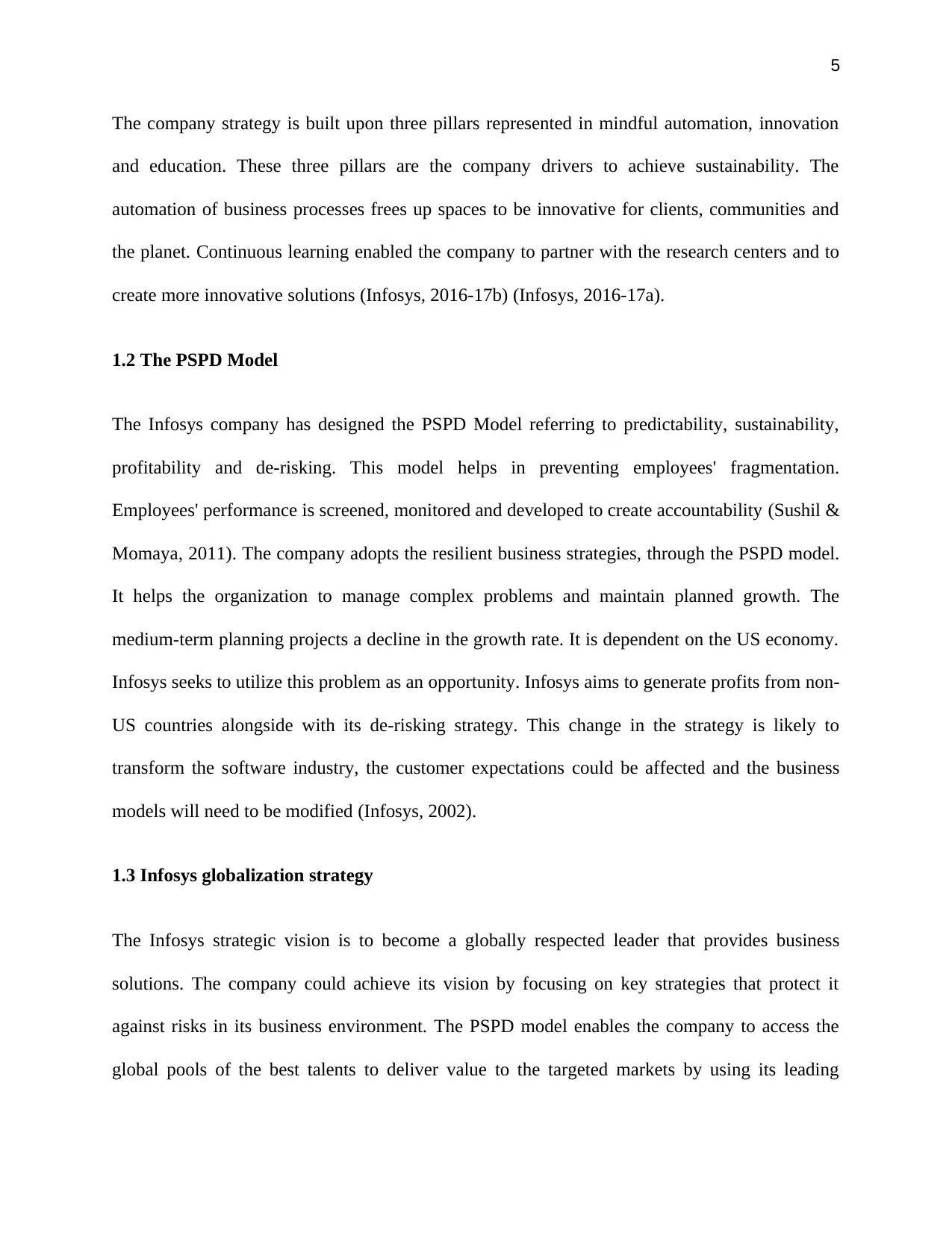
5
The company strategy is built upon three pillars represented in mindful automation, innovation
and education. These three pillars are the company drivers to achieve sustainability. The
automation of business processes frees up spaces to be innovative for clients, communities and
the planet. Continuous learning enabled the company to partner with the research centers and to
create more innovative solutions (Infosys, 2016-17b) (Infosys, 2016-17a).
1.2 The PSPD Model
The Infosys company has designed the PSPD Model referring to predictability, sustainability,
profitability and de-risking. This model helps in preventing employees' fragmentation.
Employees' performance is screened, monitored and developed to create accountability (Sushil &
Momaya, 2011). The company adopts the resilient business strategies, through the PSPD model.
It helps the organization to manage complex problems and maintain planned growth. The
medium-term planning projects a decline in the growth rate. It is dependent on the US economy.
Infosys seeks to utilize this problem as an opportunity. Infosys aims to generate profits from non-
US countries alongside with its de-risking strategy. This change in the strategy is likely to
transform the software industry, the customer expectations could be affected and the business
models will need to be modified (Infosys, 2002).
1.3 Infosys globalization strategy
The Infosys strategic vision is to become a globally respected leader that provides business
solutions. The company could achieve its vision by focusing on key strategies that protect it
against risks in its business environment. The PSPD model enables the company to access the
global pools of the best talents to deliver value to the targeted markets by using its leading
The company strategy is built upon three pillars represented in mindful automation, innovation
and education. These three pillars are the company drivers to achieve sustainability. The
automation of business processes frees up spaces to be innovative for clients, communities and
the planet. Continuous learning enabled the company to partner with the research centers and to
create more innovative solutions (Infosys, 2016-17b) (Infosys, 2016-17a).
1.2 The PSPD Model
The Infosys company has designed the PSPD Model referring to predictability, sustainability,
profitability and de-risking. This model helps in preventing employees' fragmentation.
Employees' performance is screened, monitored and developed to create accountability (Sushil &
Momaya, 2011). The company adopts the resilient business strategies, through the PSPD model.
It helps the organization to manage complex problems and maintain planned growth. The
medium-term planning projects a decline in the growth rate. It is dependent on the US economy.
Infosys seeks to utilize this problem as an opportunity. Infosys aims to generate profits from non-
US countries alongside with its de-risking strategy. This change in the strategy is likely to
transform the software industry, the customer expectations could be affected and the business
models will need to be modified (Infosys, 2002).
1.3 Infosys globalization strategy
The Infosys strategic vision is to become a globally respected leader that provides business
solutions. The company could achieve its vision by focusing on key strategies that protect it
against risks in its business environment. The PSPD model enables the company to access the
global pools of the best talents to deliver value to the targeted markets by using its leading
⊘ This is a preview!⊘
Do you want full access?
Subscribe today to unlock all pages.

Trusted by 1+ million students worldwide
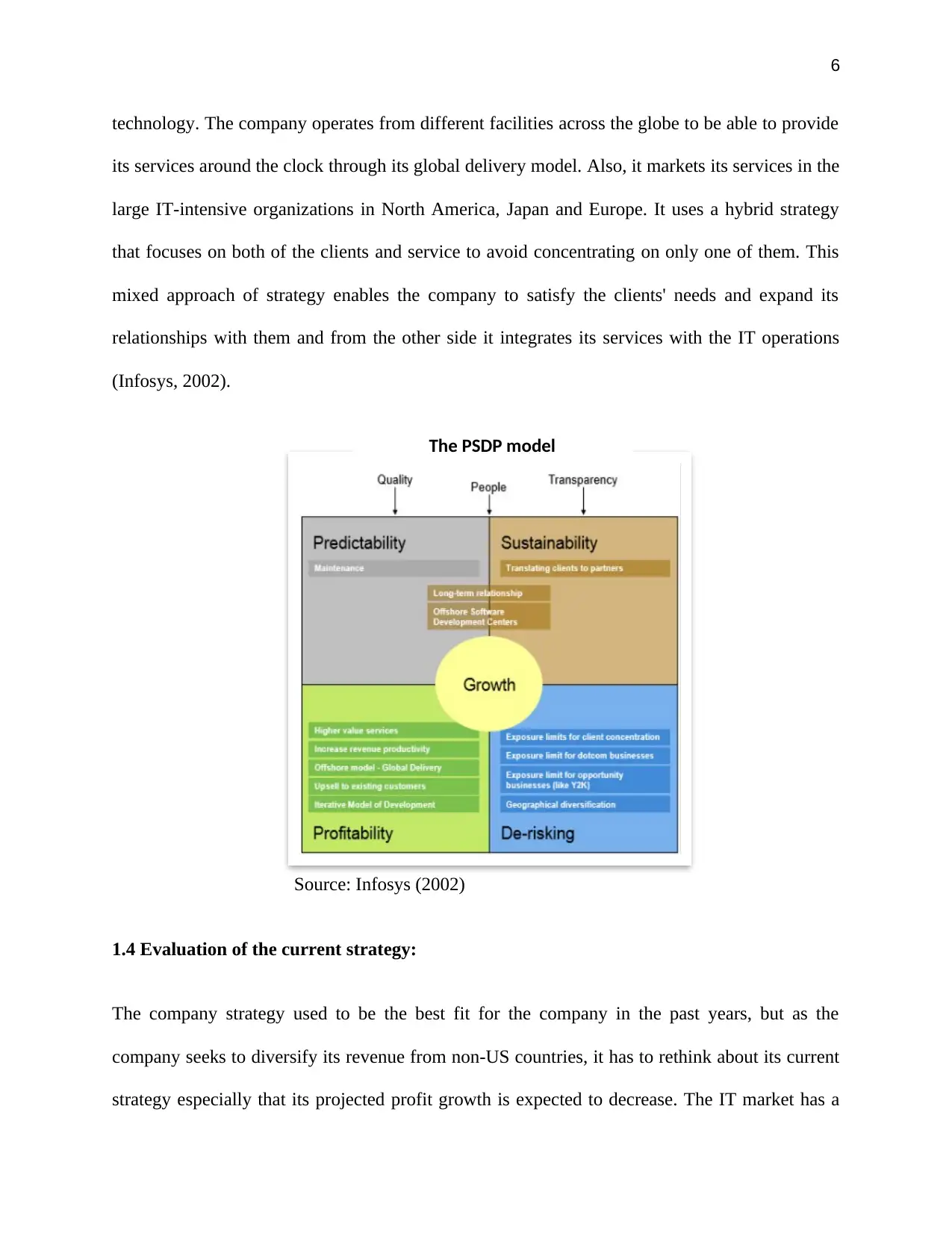
6
technology. The company operates from different facilities across the globe to be able to provide
its services around the clock through its global delivery model. Also, it markets its services in the
large IT-intensive organizations in North America, Japan and Europe. It uses a hybrid strategy
that focuses on both of the clients and service to avoid concentrating on only one of them. This
mixed approach of strategy enables the company to satisfy the clients' needs and expand its
relationships with them and from the other side it integrates its services with the IT operations
(Infosys, 2002).
Source: Infosys (2002)
1.4 Evaluation of the current strategy:
The company strategy used to be the best fit for the company in the past years, but as the
company seeks to diversify its revenue from non-US countries, it has to rethink about its current
strategy especially that its projected profit growth is expected to decrease. The IT market has a
The PSDP model
technology. The company operates from different facilities across the globe to be able to provide
its services around the clock through its global delivery model. Also, it markets its services in the
large IT-intensive organizations in North America, Japan and Europe. It uses a hybrid strategy
that focuses on both of the clients and service to avoid concentrating on only one of them. This
mixed approach of strategy enables the company to satisfy the clients' needs and expand its
relationships with them and from the other side it integrates its services with the IT operations
(Infosys, 2002).
Source: Infosys (2002)
1.4 Evaluation of the current strategy:
The company strategy used to be the best fit for the company in the past years, but as the
company seeks to diversify its revenue from non-US countries, it has to rethink about its current
strategy especially that its projected profit growth is expected to decrease. The IT market has a
The PSDP model
Paraphrase This Document
Need a fresh take? Get an instant paraphrase of this document with our AI Paraphraser
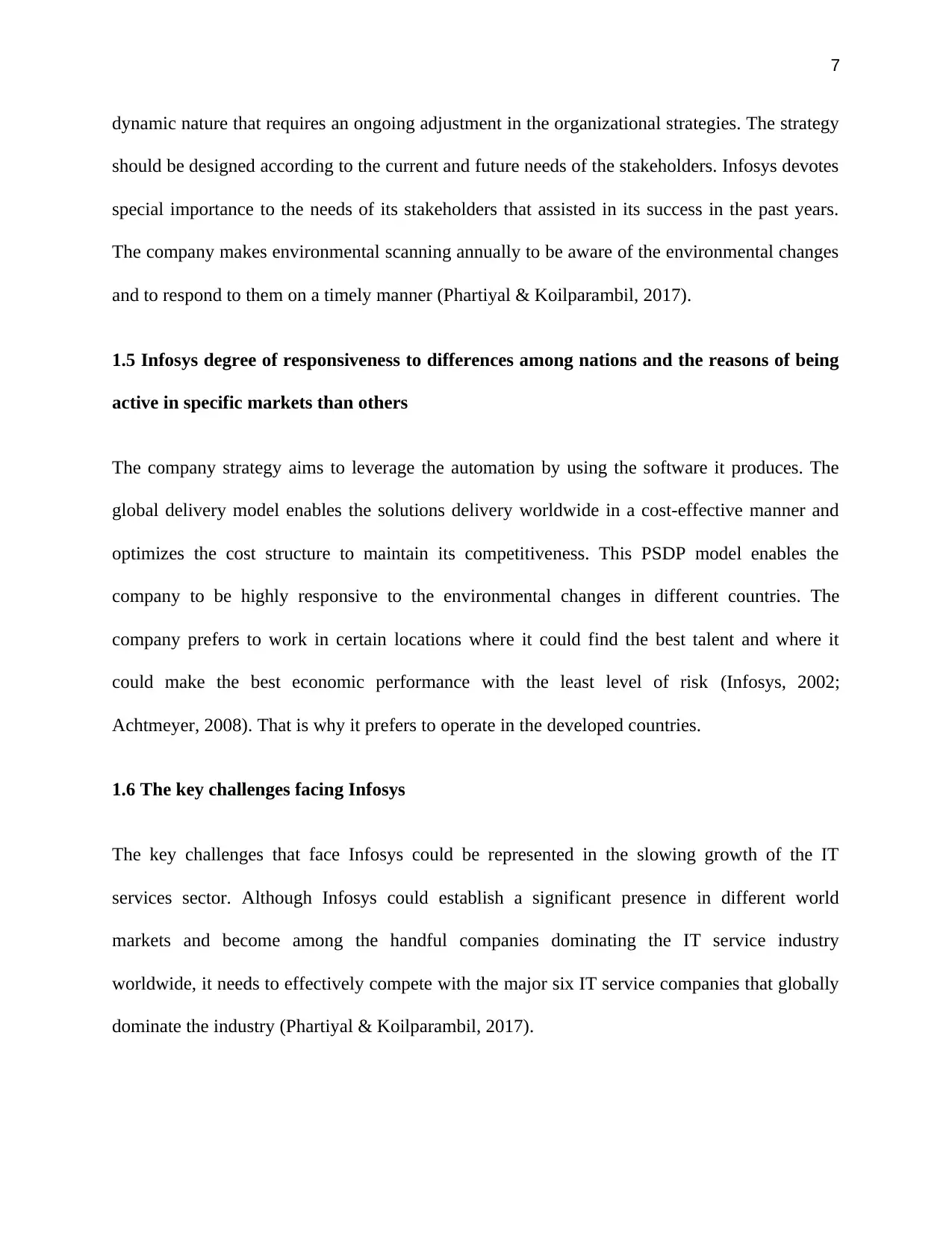
7
dynamic nature that requires an ongoing adjustment in the organizational strategies. The strategy
should be designed according to the current and future needs of the stakeholders. Infosys devotes
special importance to the needs of its stakeholders that assisted in its success in the past years.
The company makes environmental scanning annually to be aware of the environmental changes
and to respond to them on a timely manner (Phartiyal & Koilparambil, 2017).
1.5 Infosys degree of responsiveness to differences among nations and the reasons of being
active in specific markets than others
The company strategy aims to leverage the automation by using the software it produces. The
global delivery model enables the solutions delivery worldwide in a cost-effective manner and
optimizes the cost structure to maintain its competitiveness. This PSDP model enables the
company to be highly responsive to the environmental changes in different countries. The
company prefers to work in certain locations where it could find the best talent and where it
could make the best economic performance with the least level of risk (Infosys, 2002;
Achtmeyer, 2008). That is why it prefers to operate in the developed countries.
1.6 The key challenges facing Infosys
The key challenges that face Infosys could be represented in the slowing growth of the IT
services sector. Although Infosys could establish a significant presence in different world
markets and become among the handful companies dominating the IT service industry
worldwide, it needs to effectively compete with the major six IT service companies that globally
dominate the industry (Phartiyal & Koilparambil, 2017).
dynamic nature that requires an ongoing adjustment in the organizational strategies. The strategy
should be designed according to the current and future needs of the stakeholders. Infosys devotes
special importance to the needs of its stakeholders that assisted in its success in the past years.
The company makes environmental scanning annually to be aware of the environmental changes
and to respond to them on a timely manner (Phartiyal & Koilparambil, 2017).
1.5 Infosys degree of responsiveness to differences among nations and the reasons of being
active in specific markets than others
The company strategy aims to leverage the automation by using the software it produces. The
global delivery model enables the solutions delivery worldwide in a cost-effective manner and
optimizes the cost structure to maintain its competitiveness. This PSDP model enables the
company to be highly responsive to the environmental changes in different countries. The
company prefers to work in certain locations where it could find the best talent and where it
could make the best economic performance with the least level of risk (Infosys, 2002;
Achtmeyer, 2008). That is why it prefers to operate in the developed countries.
1.6 The key challenges facing Infosys
The key challenges that face Infosys could be represented in the slowing growth of the IT
services sector. Although Infosys could establish a significant presence in different world
markets and become among the handful companies dominating the IT service industry
worldwide, it needs to effectively compete with the major six IT service companies that globally
dominate the industry (Phartiyal & Koilparambil, 2017).
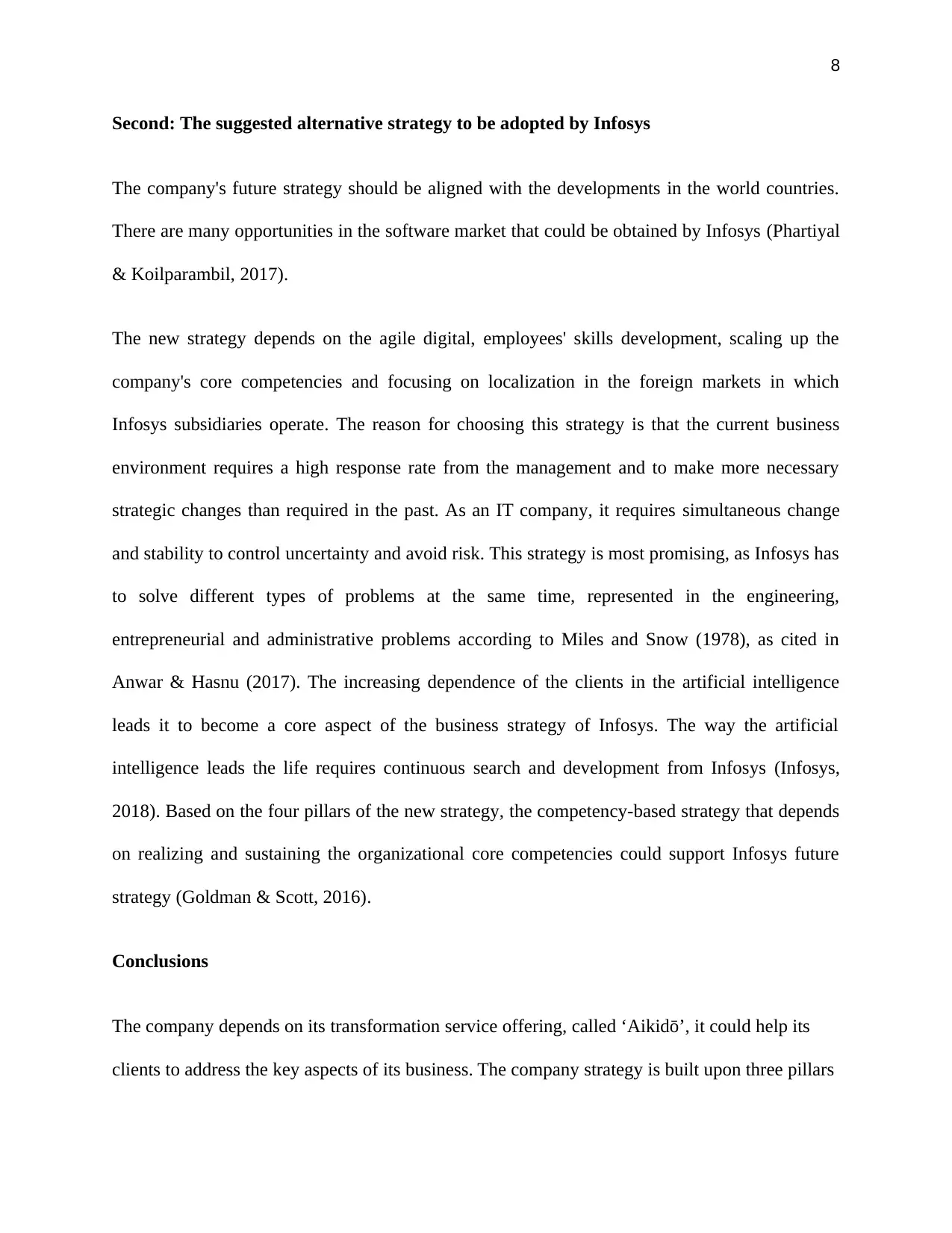
8
Second: The suggested alternative strategy to be adopted by Infosys
The company's future strategy should be aligned with the developments in the world countries.
There are many opportunities in the software market that could be obtained by Infosys (Phartiyal
& Koilparambil, 2017).
The new strategy depends on the agile digital, employees' skills development, scaling up the
company's core competencies and focusing on localization in the foreign markets in which
Infosys subsidiaries operate. The reason for choosing this strategy is that the current business
environment requires a high response rate from the management and to make more necessary
strategic changes than required in the past. As an IT company, it requires simultaneous change
and stability to control uncertainty and avoid risk. This strategy is most promising, as Infosys has
to solve different types of problems at the same time, represented in the engineering,
entrepreneurial and administrative problems according to Miles and Snow (1978), as cited in
Anwar & Hasnu (2017). The increasing dependence of the clients in the artificial intelligence
leads it to become a core aspect of the business strategy of Infosys. The way the artificial
intelligence leads the life requires continuous search and development from Infosys (Infosys,
2018). Based on the four pillars of the new strategy, the competency-based strategy that depends
on realizing and sustaining the organizational core competencies could support Infosys future
strategy (Goldman & Scott, 2016).
Conclusions
The company depends on its transformation service offering, called ‘Aikidō’, it could help its
clients to address the key aspects of its business. The company strategy is built upon three pillars
Second: The suggested alternative strategy to be adopted by Infosys
The company's future strategy should be aligned with the developments in the world countries.
There are many opportunities in the software market that could be obtained by Infosys (Phartiyal
& Koilparambil, 2017).
The new strategy depends on the agile digital, employees' skills development, scaling up the
company's core competencies and focusing on localization in the foreign markets in which
Infosys subsidiaries operate. The reason for choosing this strategy is that the current business
environment requires a high response rate from the management and to make more necessary
strategic changes than required in the past. As an IT company, it requires simultaneous change
and stability to control uncertainty and avoid risk. This strategy is most promising, as Infosys has
to solve different types of problems at the same time, represented in the engineering,
entrepreneurial and administrative problems according to Miles and Snow (1978), as cited in
Anwar & Hasnu (2017). The increasing dependence of the clients in the artificial intelligence
leads it to become a core aspect of the business strategy of Infosys. The way the artificial
intelligence leads the life requires continuous search and development from Infosys (Infosys,
2018). Based on the four pillars of the new strategy, the competency-based strategy that depends
on realizing and sustaining the organizational core competencies could support Infosys future
strategy (Goldman & Scott, 2016).
Conclusions
The company depends on its transformation service offering, called ‘Aikidō’, it could help its
clients to address the key aspects of its business. The company strategy is built upon three pillars
⊘ This is a preview!⊘
Do you want full access?
Subscribe today to unlock all pages.

Trusted by 1+ million students worldwide
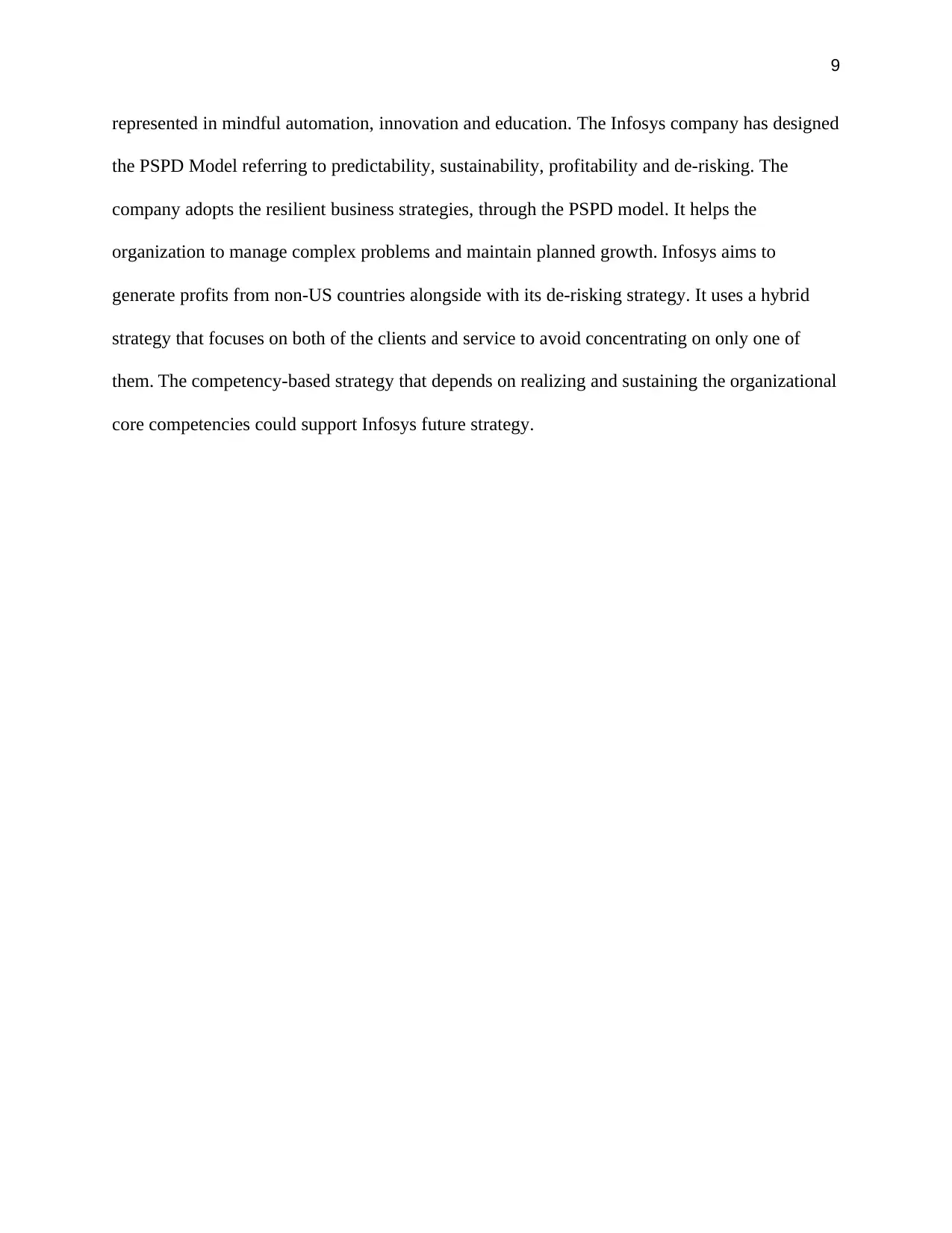
9
represented in mindful automation, innovation and education. The Infosys company has designed
the PSPD Model referring to predictability, sustainability, profitability and de-risking. The
company adopts the resilient business strategies, through the PSPD model. It helps the
organization to manage complex problems and maintain planned growth. Infosys aims to
generate profits from non-US countries alongside with its de-risking strategy. It uses a hybrid
strategy that focuses on both of the clients and service to avoid concentrating on only one of
them. The competency-based strategy that depends on realizing and sustaining the organizational
core competencies could support Infosys future strategy.
represented in mindful automation, innovation and education. The Infosys company has designed
the PSPD Model referring to predictability, sustainability, profitability and de-risking. The
company adopts the resilient business strategies, through the PSPD model. It helps the
organization to manage complex problems and maintain planned growth. Infosys aims to
generate profits from non-US countries alongside with its de-risking strategy. It uses a hybrid
strategy that focuses on both of the clients and service to avoid concentrating on only one of
them. The competency-based strategy that depends on realizing and sustaining the organizational
core competencies could support Infosys future strategy.
Paraphrase This Document
Need a fresh take? Get an instant paraphrase of this document with our AI Paraphraser
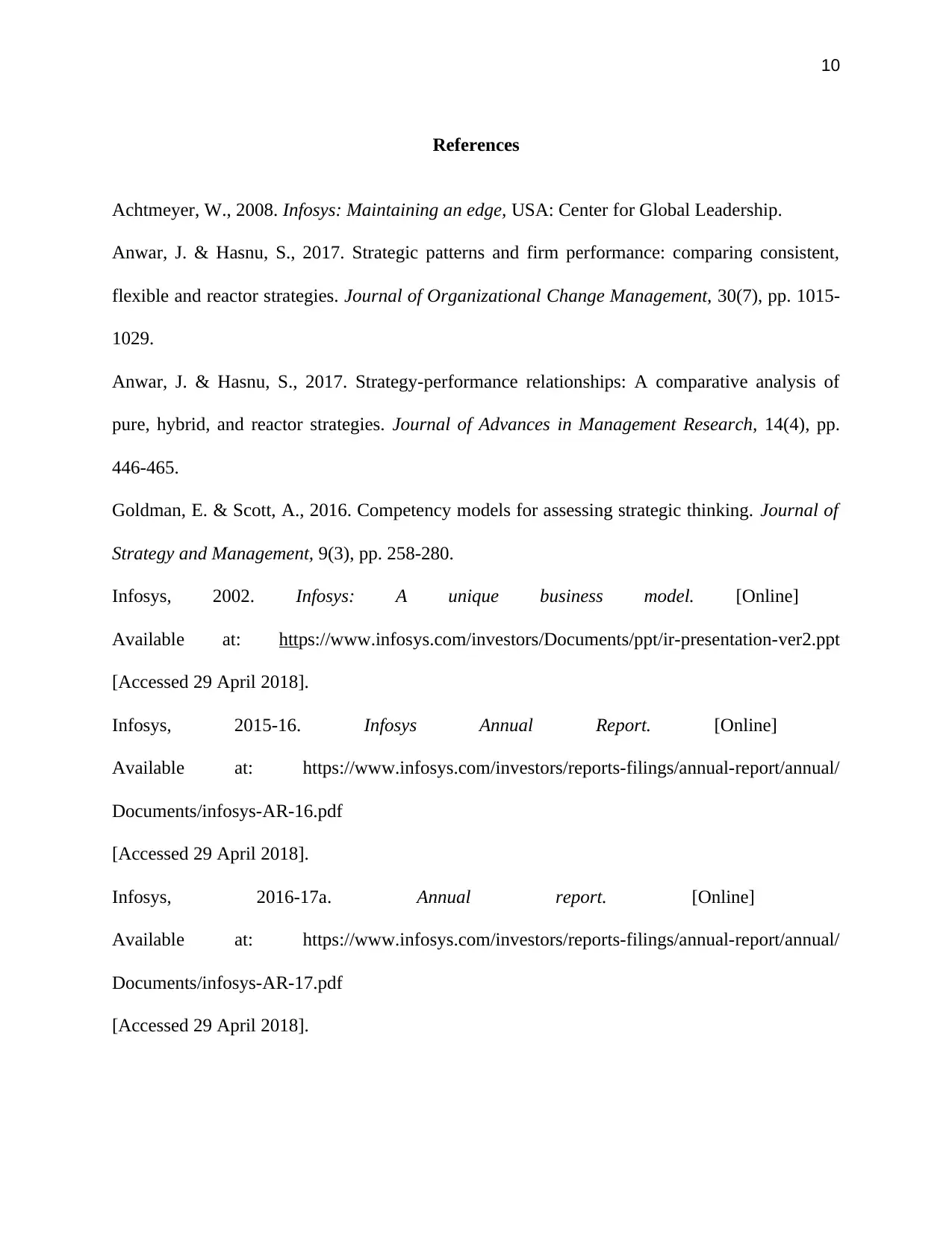
10
References
Achtmeyer, W., 2008. Infosys: Maintaining an edge, USA: Center for Global Leadership.
Anwar, J. & Hasnu, S., 2017. Strategic patterns and firm performance: comparing consistent,
flexible and reactor strategies. Journal of Organizational Change Management, 30(7), pp. 1015-
1029.
Anwar, J. & Hasnu, S., 2017. Strategy-performance relationships: A comparative analysis of
pure, hybrid, and reactor strategies. Journal of Advances in Management Research, 14(4), pp.
446-465.
Goldman, E. & Scott, A., 2016. Competency models for assessing strategic thinking. Journal of
Strategy and Management, 9(3), pp. 258-280.
Infosys, 2002. Infosys: A unique business model. [Online]
Available at: https://www.infosys.com/investors/Documents/ppt/ir-presentation-ver2.ppt
[Accessed 29 April 2018].
Infosys, 2015-16. Infosys Annual Report. [Online]
Available at: https://www.infosys.com/investors/reports-filings/annual-report/annual/
Documents/infosys-AR-16.pdf
[Accessed 29 April 2018].
Infosys, 2016-17a. Annual report. [Online]
Available at: https://www.infosys.com/investors/reports-filings/annual-report/annual/
Documents/infosys-AR-17.pdf
[Accessed 29 April 2018].
References
Achtmeyer, W., 2008. Infosys: Maintaining an edge, USA: Center for Global Leadership.
Anwar, J. & Hasnu, S., 2017. Strategic patterns and firm performance: comparing consistent,
flexible and reactor strategies. Journal of Organizational Change Management, 30(7), pp. 1015-
1029.
Anwar, J. & Hasnu, S., 2017. Strategy-performance relationships: A comparative analysis of
pure, hybrid, and reactor strategies. Journal of Advances in Management Research, 14(4), pp.
446-465.
Goldman, E. & Scott, A., 2016. Competency models for assessing strategic thinking. Journal of
Strategy and Management, 9(3), pp. 258-280.
Infosys, 2002. Infosys: A unique business model. [Online]
Available at: https://www.infosys.com/investors/Documents/ppt/ir-presentation-ver2.ppt
[Accessed 29 April 2018].
Infosys, 2015-16. Infosys Annual Report. [Online]
Available at: https://www.infosys.com/investors/reports-filings/annual-report/annual/
Documents/infosys-AR-16.pdf
[Accessed 29 April 2018].
Infosys, 2016-17a. Annual report. [Online]
Available at: https://www.infosys.com/investors/reports-filings/annual-report/annual/
Documents/infosys-AR-17.pdf
[Accessed 29 April 2018].
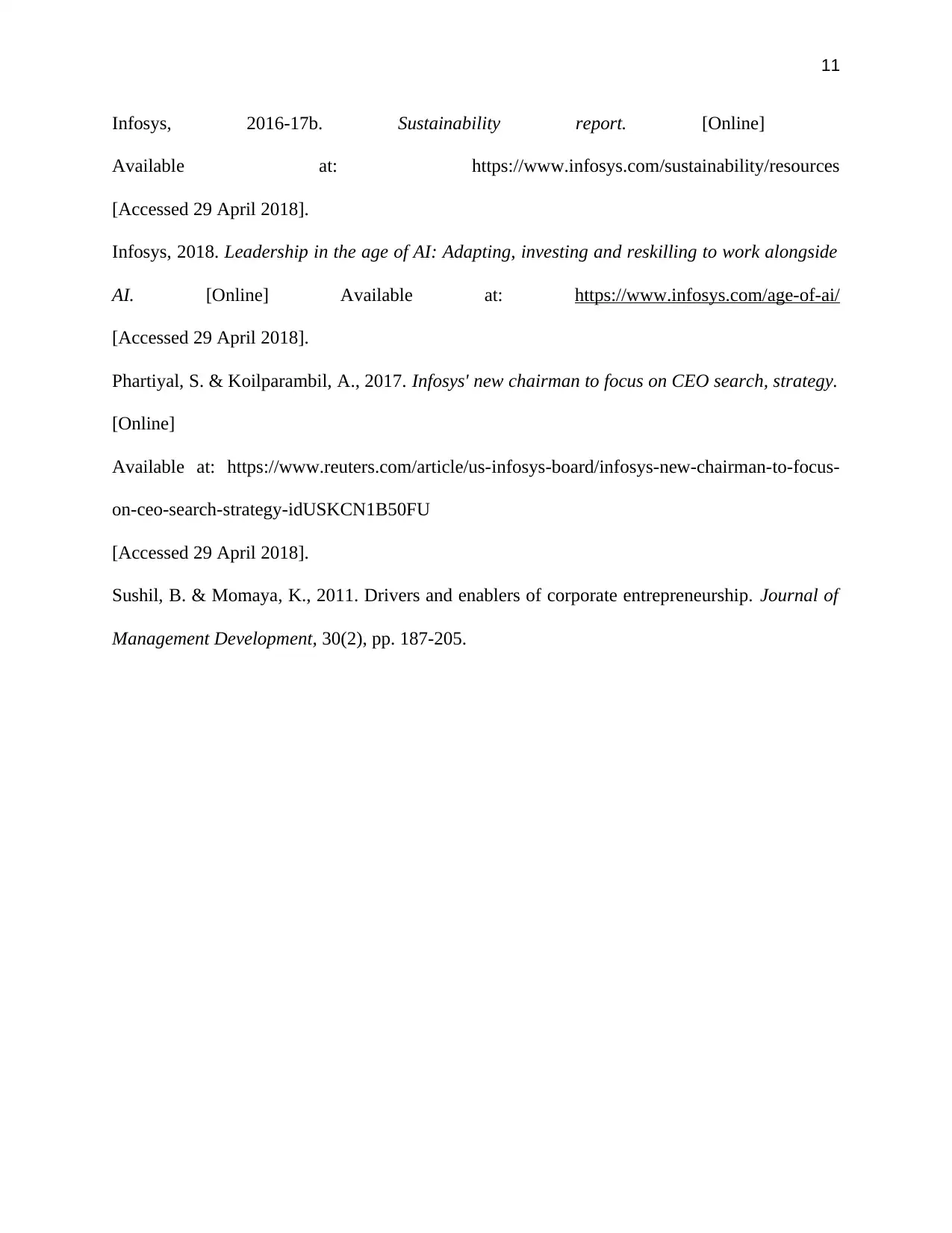
11
Infosys, 2016-17b. Sustainability report. [Online]
Available at: https://www.infosys.com/sustainability/resources
[Accessed 29 April 2018].
Infosys, 2018. Leadership in the age of AI: Adapting, investing and reskilling to work alongside
AI. [Online] Available at: https://www.infosys.com/age-of-ai/
[Accessed 29 April 2018].
Phartiyal, S. & Koilparambil, A., 2017. Infosys' new chairman to focus on CEO search, strategy.
[Online]
Available at: https://www.reuters.com/article/us-infosys-board/infosys-new-chairman-to-focus-
on-ceo-search-strategy-idUSKCN1B50FU
[Accessed 29 April 2018].
Sushil, B. & Momaya, K., 2011. Drivers and enablers of corporate entrepreneurship. Journal of
Management Development, 30(2), pp. 187-205.
Infosys, 2016-17b. Sustainability report. [Online]
Available at: https://www.infosys.com/sustainability/resources
[Accessed 29 April 2018].
Infosys, 2018. Leadership in the age of AI: Adapting, investing and reskilling to work alongside
AI. [Online] Available at: https://www.infosys.com/age-of-ai/
[Accessed 29 April 2018].
Phartiyal, S. & Koilparambil, A., 2017. Infosys' new chairman to focus on CEO search, strategy.
[Online]
Available at: https://www.reuters.com/article/us-infosys-board/infosys-new-chairman-to-focus-
on-ceo-search-strategy-idUSKCN1B50FU
[Accessed 29 April 2018].
Sushil, B. & Momaya, K., 2011. Drivers and enablers of corporate entrepreneurship. Journal of
Management Development, 30(2), pp. 187-205.
⊘ This is a preview!⊘
Do you want full access?
Subscribe today to unlock all pages.

Trusted by 1+ million students worldwide
1 out of 12
Related Documents
Your All-in-One AI-Powered Toolkit for Academic Success.
+13062052269
info@desklib.com
Available 24*7 on WhatsApp / Email
![[object Object]](/_next/static/media/star-bottom.7253800d.svg)
Unlock your academic potential
Copyright © 2020–2025 A2Z Services. All Rights Reserved. Developed and managed by ZUCOL.





